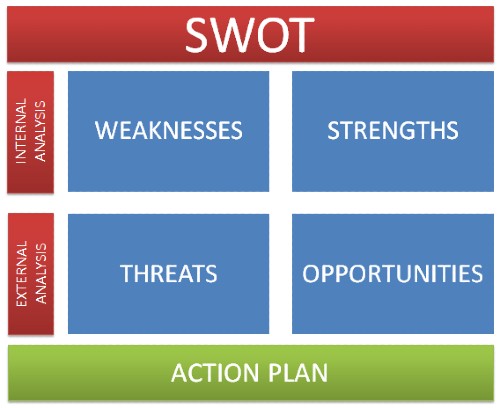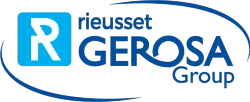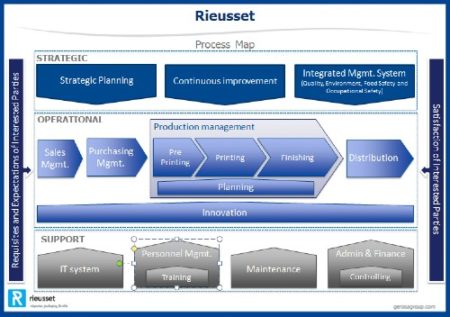
09 Oct Identification of risks and opportunities in Rieusset: SWOT
Rieusset, which has been ISO 9001 certified since the year 2000, is going to get certified to the new version before the end of the year, which is why today we want to share with you something new in this respect.
The new version of ISO 9001:2015 requires understanding the organization and its context, and this time, more concretely, it is necessary to understand the needs and expectations of the interested parties (point 4.2 of the regulation) as well as to focus on and set the risks and opportunities of the organization (point 6.1).
These requisites oblige us to analyze our organization in depth, and since this is no simple task, it is advisable to use the tools that can help us do this.
One of these tools, probably the one that is used the most, is the SWOT analysis –whose name corresponds to the initials for Strengths, Weaknesses, Opportunities and Threats, a method that was presented in 1965 by a group of professors of the Harvard Business School, made up of Edmund Learned, Roland Christensen, Kenneth Andrews and William Guth.
The main objective of a SWOT analysis is to help an organization find its critical strategic factors, so that once these have been identified, they can be used to support organizational changes by
- … reinforcing the strengths,
- … minimizing the weaknesses,
- … exploiting the opportunities and
- … eliminating or reducing the threats
During the analysis, we must keep in mind that the strengths and weaknesses correspond to internal elements of the organization, and that, among others, it should make us evaluate aspects such as the availability of resources, the structure of the departments or the quality of the product.
In order to facilitate this task we can ask ourselves questions such as:
- What could be avoided?
- What should be improved?
- What disadvantages are there in the company or the department?
- What do we think we are doing wrong?
- What affects our efficiency?
In the same way, we must also keep in mind that threats and opportunities correspond to external elements of the organization.
Threats are negative factors that can affect the company’s goal and must be kept in mind in order to analyze if it is necessary to set up actions to bypass them.
- What obstacles might the company encounter during the development of its business?
- What are our competitors doing?
- What is the Administration planning on doing?
Opportunities, on the other hand, are positive factors which, if we work with them can enable us to achieve an advantage in the market.
- Is there any market trend that may benefit us?
- Are there new technologies that we can apply to our products?
- Are there any changes in the regulations that may benefit us?
Up to here is the, let’s say, theoretical part, but how have we developed this in Rieusset?
The first thing we did in Rieusset was ask ourselves if we would use this tool at the strategic level or if we could also employ it on the operational level.
And we decided that we could use it in the entire organization.
Based on the process map of Rieusset we decided to apply the SWOT analysis to the strategic processes as well as to the operational and support processes.
So we started by introducing the SWOT tool to all persons in charge of processes and we explained to them how they should use it.
The orientation we gave them is the same that is followed in a strategic SWOT analysis, only here the scope is not so much the organization but rather the department or the process itself.
As this was the first time we used this at the process level, and anticipating that this would generate an action plan requiring a lot of resources, before the preparation of the process SWOT analysis we presented the strategic SWOT analysis. This way we wanted to give priority to the actions that would derive from these process SWOT analyses.
Once the SWOT was established, we assessed the weaknesses and the opportunities considering the strengths and the threats. In fact, we contemplated the opportunities based on the threats.
In order to make the risk assessment we analyzed its probability and its impact. With probability we understand precisely the probability of the weakness appearing, and with impact what this would mean for the organization.
We gave both concepts a rating between 1 and 3, with 1 being a low probability or impact and 3 a high probability or impact.
From the product of these factors we obtain the risk that we run in the organization.
Risk = Probability x Impact
In order to be able to prioritize an action plan, in Rieusset we have established that those risks with a value of 6 or higher obligatorily require an action, leaving the rest up to the criteria of the area manager who knows which resources he has available to him for tackling them.
But that’s not all.
At the beginning of this post we commented that the new version of ISO 9001 requires us to understand the needs and expectations of the interested parties. And how have we done this part?
Let’s leave this point for our next post where we think we have also gotten a little bit ahead of what the regulations will require of us in times to come.
Don’t hesitate to contact us with your comments.
| We Manufacture: | Meet Rieusset: |





